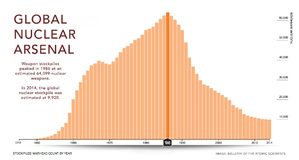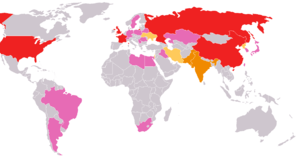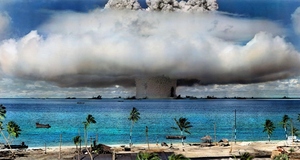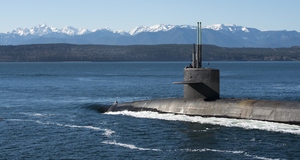From Interstate - Journal of International Affairs VOL. 1996/1997 NO. 2Nuclear Weapons Proliferation and the Efficacy of Deterrence
By
Interstate - Journal of International Affairs 1997, Vol. 1996/1997 No. 2 | pg. 1/1
KEYWORDS:
Nuclear weapons were first used in anger during the Second World War against the Japanese. The Horishima and Nagasaki experience left nobody in any doubt that nuclear weapons were unique. Never before had so much destruction been meted out so suddenly by just two bombs. By the mid-1960s the number of countries openly possessing nuclear weapons had risen to five. The United States had been the first, closely followed by the Soviet Union, Britain, France, and China. The 1968 Nuclear Non-Proliferation Treaty set out to prevent the further spread of nuclear weapons by making it illegal for non-nuclear signatories to receive or manufacture nuclear explosives. Whatever ulterior motives existed for putting in place a strict non-proliferation regime, the traditional reasons cited have emphasised the perceived unsuitability of many countries to possess weapons of such destruction and the dangers which could result if they were ever to make such an acquisition. The nature of nuclear weapons demands that these dangers are not simply ignored. The other side to nuclear weapons, however, is that since their advent there has been a marked absence of major world war. Despite the tensions in evidence between the United States and the Soviet Union at the height of the Cold War, their hostility towards each other did not erupt into direct military conflict. The deterrent capacity of nuclear weapons undoubtedly played an important role in the superpower relationship, keeping any tendency towards war in check. The suggestion is that a proliferation of nuclear weapons would allow this experience to be transferred to other potential conflict regions of the world and hence reduce the likelihood of major conflict. The make or break potential of nuclear weapons so described has thus spurred a debate between proliferation ‘pessimists’ and proliferation ‘optimists’. The following article takes a look at some of the arguments advanced by either side and attempts to identify which approach should be adopted in practice. Two openly hostile states share a common border. What happens when they both acquire nuclear weapons? Those pessimistic about nuclear proliferation argue that pre-emptive strikes will become a possible and highly dangerous outcome. One of the main reasons for this is the supposition that forces of new nuclear states will be “delicate.” (1) It is argued that the lack of a secure retaliatory second-strike capability will increase tension and encourage either state to pre-empt the other and to launch a disarming nuclear first-strike. The crucial point at issue here is whether or not second-strike stability will in fact exist and if so whether deterrence will therefore operate. Those who emphasise the universality of deterrence do not consider there to be a problem in the above instance. Nuclear forces, according to Kenneth Waltz, “can easily be made sturdy.” Waltz, who is the chief proponent of the ‘more may be better’ argument, certainly has a point. If terrorists with comparatively few means are thought to be capable of safely hiding and concealing nuclear weapons (which can be relatively small) then surely states, however pushed for resources, must also be able to do so. (2) But is to predict that this would always be the case a gamble worth taking? The worry that nuclear proliferation will see hostile countries, sharing a common border, unable to resist firing nuclear weapons at each other is apparently “a worry about the future which the past [and present] does not disclose.” (3) The Soviet Union and China shared a common border yet refrained from embarking on a nuclear exchange. Another useful example is India and Pakistan, both of which have, or are believed to have, already built up a nuclear weapons capability. (4) The uncertainty, in this instance, as to what the capability entails is important. Writing about proliferation in South Asia, Stephen Cohen observes that, President Zia [of Pakistan] stated the obvious when he told visitors in 1988 that India and Pakistan had achieved deterrence stability because of uncertainty as to whether each possessed nuclear weapons and how many they might have . (5) Despite their situation, India and Pakistan have not become locked in full-scale war. This would seem to support the Waltzian perspective that deterrence is easy, assuming that no state will ever be able to determine beyond doubt the real capabilities of its adversary. The problem, however, lies in determining whether or not the leadership of every new nuclear state will be susceptible to deterrence logic. Can one be certain that the future will always be a replication of the past? This is the big question posed by proliferation pessimists who fear that the spreading of nuclear weapons will not necessarily always carry with it the deterrent benefits that were in evidence between the United States and the Soviet Union during the Cold War. As Scott Sagan asserts in his response to Waltz, “[t]he assumption that states behave in a basically rational manner is of course an assumption, not an empirically tested insight.” (6) There is good reason to believe that potential proliferators might be governed by leaders with a questionable rationale for using weapons of mass destruction, that such leaders will be more willing to take high-risk gambles and use nuclear weapons “to serve their causes.” (7) Keen to refute this, Waltz argues that despite ‘irrational’ characteristics, leaders of countries identified with such by the Western world, Qaddafi of Libya an example, have on numerous occasions shown caution and modesty. Rulers, however mad and insane they might appear to be will always want a country that they can continue to rule. They are very unlikely, therefore, to pursue actions that jeopardise this, such as deliberately provoking a nuclear attack. (8) Shai Feldman comes to similar conclusions in his examination of the likely impact of nuclear weapons on the Middle East, stating that there is “not…the slightest indication that Arabs would regard these weapons as simply more of the same.” (9) The reasoning is convincing, but different conclusions can be reached depending on which evidence one chooses to look at. During the Iran-Iraq War, for example, Iraq used chemical weapons against Iran, directly violating the 1925 Geneva protocol which it had signed in 1931. Iraq’s use of such a weapon could indicate that it will not behave any more responsibly with nuclear weapons. Firing Scud missiles at Israel during the 1991 Gulf War further suggests that Saddam Hussein might not be as concerned about the consequences of provoking a nuclear response as proliferation optimists would have us believe. Evidently the regional consequences of nuclear proliferation raise some important questions, but what are the wider implications of nuclear weapons proliferation? How will emergent nuclear states affect stability on an international scale? For Stanley Hoffmann, “a world of many nuclear states would raise extremely difficult issues of management.” The crucial factor is perceived to be the resultant increase in difficulty in decision making, that more nuclear powers will complicate calculations and that mis-perceptions will become more dangerous and more likely as a consequence. It is argued that the relatively clear-cut bipolarity which characterised the Cold War would diminish and that “uncertainties will tempt instead of deter.” Having got used to a stable nuclear world, states may start to take the deterrent effect of nuclear weapons for granted and in so doing become more and more daring in their foreign policy aims. (10) Nuclear weapons possession might create ambitions, ambitions which are likely to be conflictual. Coupled to the above is the prospect of a reduction in the freedom of action of the major powers, mainly the United States and Russia, and tied up with this is the question of how the deterrence relationship will develop between small and major nuclear powers. (11) The worry of proliferation pessimists is that additional nuclear states will increase the risks major powers will have to face in their efforts to intervene in and defuse conflict situations. The heightened probability that nuclear weapons will be present and of the potential for escalation to the nuclear level which will therefore exist, will, it is thought, significantly increase the costs of such intervention and hence be a deterrent to this. Furthermore, fearing a proliferated world, it is argued that non-nuclear states concerned for their security, especially as the deterrent umbrella provided by the United States and Russia recedes, will become locked into a global nuclear arms race where the urgency to acquire nuclear weapons takes precedent over safety. The picture painted by proliferation pessimists in this case is one of doom and gloom and it is difficult not to appreciate and mirror their concern. There are, however, glimmers of optimism. Ted Greenwood argues that “[a]s the United States and the [old] Soviet Union have found, when other nuclear powers are involved in a dispute, or might become so, the spectre of nuclear conflagration usually encourages caution.” (12) Waltz is in agreement with this and the idea that by complicating calculations, nuclear weapons proliferation actually strengthens deterrence. The possibility of mis-perceptions mentioned above, or rather the uncertainty that mis-perceptions might or might not result, arguably encourages states to take even greater care than they perhaps might have previously. Additionally, presuming that every state will indeed be responsive to deterrence, new nuclear states who have traditionally been at the mercy of the tyranny of its larger neighbours might be able to assume a more equable existence. (13) At first sight, both sides of the debate seem to have a convincing case. Both pessimists and optimists draw on past examples to support their arguments, showing just what could happen and what has not happened. Where should the emphasis lie? Examples have been given where it is thought rational deterrence theory will not operate, yet at the same time various reasons seem to exist directing one to believe that it does, and will, and that the wider benefits of nuclear proliferation will indeed result. The tendency towards stalemate, however, is undermined by the failure of optimists to absolutely rule out the dangers for the future. There is no guarantee, for example, that every potential nuclear weapons possessor would recognise the constraints that, in any sane world, nuclear weapons inevitably impose. This shifts the argument in favour of the pessimistic approach. The unpredictability of the future and the very nature of nuclear weapons makes optimism about the advantages of nuclear weapons proliferation look increasingly misplaced. So while it may be possible to advocate proliferation from a theoretical standpoint it would be madness to advance such theory in practice. Endnotes
Suggested Reading from Inquiries Journal
Inquiries Journal provides undergraduate and graduate students around the world a platform for the wide dissemination of academic work over a range of core disciplines. Representing the work of students from hundreds of institutions around the globe, Inquiries Journal's large database of academic articles is completely free. Learn more | Blog | Submit Latest in International Affairs |



















